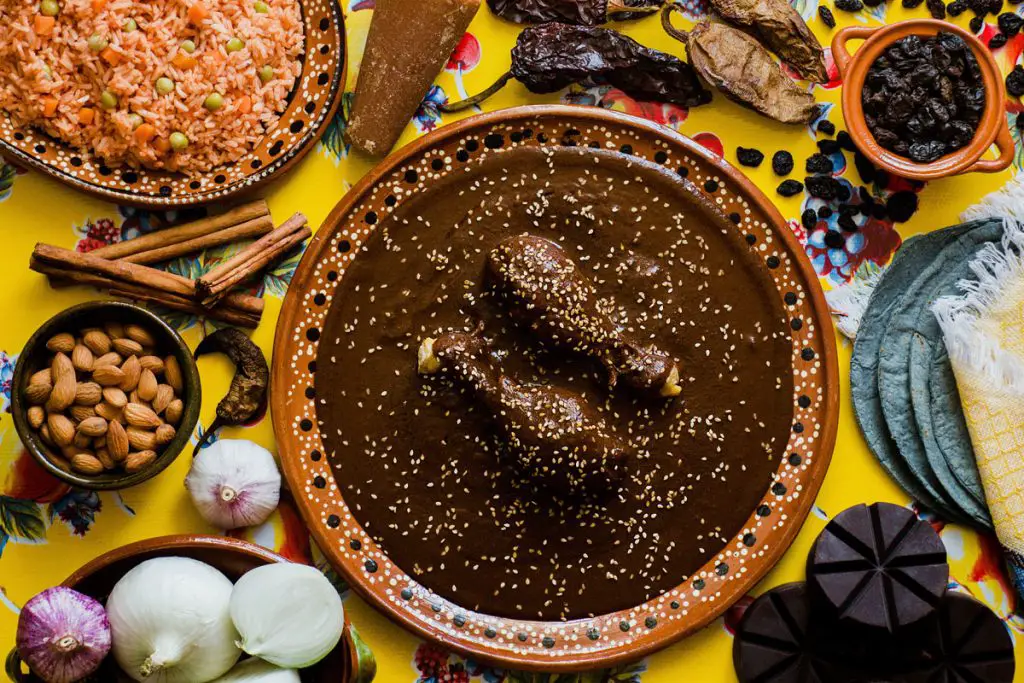Mexican cuisine is renowned for its bold flavors, vibrant colors, and a rich tapestry of cultural influences. Among its most celebrated dishes is Mole Poblano, a complex and savory sauce that has captured the hearts and taste buds of food enthusiasts around the world. In this 2,000-word article, we will take a deep dive into the history, ingredients, preparation, and cultural significance of Mole Poblano, as well as provide you with a step-by-step recipe to recreate this culinary masterpiece in your own kitchen.
The Origins of Mole Poblano
Mole Poblano, often referred to simply as “mole,” has a history that dates back centuries. Its origins can be traced to the city of Puebla, located in central Mexico. While the exact history of mole is shrouded in legend and folklore, it is widely believed that this complex sauce was created by blending indigenous Mexican ingredients with Spanish and other international influences during the colonial period.
One popular legend surrounding the creation of Mole Poblano tells of a group of nuns from the Santa Rosa convent in Puebla who prepared the dish for a visiting archbishop. In a moment of panic and inspiration, they combined various ingredients they had on hand, resulting in the creation of this now-famous sauce. Regardless of its true origins, mole has become an integral part of Mexican cuisine and is prepared with reverence and pride throughout the country.
Ingredients That Define Mole Poblano
Mole Poblano is known for its intricate combination of ingredients, which can vary slightly depending on the region and family traditions. However, several key components are essential to the authenticity and flavor of this dish:
Chiles: The backbone of Mole Poblano is dried chiles, and a variety of them are used. Common choices include Ancho, Pasilla, Mulato, and Chipotle chiles. These provide the sauce with its smoky, earthy, and spicy undertones.
Chocolate: Chocolate, particularly dark chocolate, adds depth and sweetness to the mole. The chocolate used in Mole Poblano is not the sweet, milk chocolate most people associate with candy bars, but rather a bitter, unsweetened chocolate that balances the heat from the chiles.
Nuts and Seeds: Almonds, peanuts, and sesame seeds are often toasted and ground into a paste to give Mole Poblano its rich, nutty flavor and thick consistency.
Spices: A medley of spices such as cinnamon, cloves, and black pepper contribute to the complexity of the mole’s flavor profile.
Tomatoes and Tomatillos: These ingredients provide acidity and depth to the sauce, balancing the richness of the chocolate and nuts.
Chicken or Turkey Stock: Many traditional Mole Poblano recipes call for using chicken or turkey stock as a base, infusing the sauce with a savory, meaty essence.
Bread or Tortillas: Stale bread or tortillas are often added to Mole Poblano to thicken the sauce and give it a silky texture.
Onions and Garlic: These aromatic vegetables provide the base flavor for the sauce.
Lard or Vegetable Oil: Depending on dietary preferences, traditional recipes may use lard, while contemporary versions often opt for vegetable oil.
Preparing Mole Poblano: A Step-By-Step Recipe
Now that we’ve explored the ingredients, let’s embark on the journey of creating Mole Poblano in your own kitchen. This recipe serves approximately 6-8 people.
Ingredients:
6-8 pieces of bone-in, skin-on chicken (thighs and drumsticks work well)
4-6 dried Ancho chiles
2-3 dried Pasilla chiles
2-3 dried Mulato chiles
1 dried Chipotle chile (adjust for desired spiciness)
1 onion, chopped
3 cloves garlic, minced
1/2 cup almonds
1/4 cup peanuts
2 tbsp sesame seeds
2 slices of stale bread or 2 corn tortillas
1/4 tsp cinnamon
1/4 tsp cloves
1/4 tsp black pepper
1/4 tsp cumin
2 tomatoes, roasted and peeled
2 tomatillos, roasted and peeled
1/4 cup dark chocolate (70% cocoa or higher)
4 cups chicken or turkey stock
2 tbsp lard or vegetable oil
Salt, to taste
Instructions:
Begin by toasting the dried chiles in a dry skillet over medium heat. Press them down with a spatula until they become fragrant and pliable. Be careful not to burn them, as this can make the sauce bitter. Remove the stems and seeds from the chiles.
In a separate skillet, toast the almonds, peanuts, and sesame seeds until they turn golden brown. Remove from heat.
In the same skillet, toast the slices of bread or tortillas until they are crisp and browned.
Place the toasted chiles, nuts, seeds, bread or tortillas, cinnamon, cloves, black pepper, cumin, roasted tomatoes, roasted tomatillos, and dark chocolate in a blender or food processor. Add a cup of chicken or turkey stock, and blend until you have a smooth, thick paste. Set aside.
In a large, heavy-bottomed pot, heat the lard or vegetable oil over medium-high heat. Add the chopped onion and minced garlic, and sauté until they become translucent.
Add the chicken or turkey pieces to the pot and brown them on all sides.
Pour the chile paste from the blender into the pot, stirring constantly to incorporate it with the chicken and onions.
Gradually add the remaining chicken or turkey stock to the pot, stirring continuously to ensure the sauce is smooth and well-mixed.
Reduce the heat to low and simmer the mole for 1-2 hours, stirring occasionally, until the sauce has thickened and the chicken is cooked through. If the mole becomes too thick, you can add more stock to reach your desired consistency.
Season the mole with salt to taste. The mole should have a balanced flavor profile of sweet, spicy, and savory.
Serve the Mole Poblano over cooked rice or with warm tortillas, garnishing with sesame seeds or chopped cilantro if desired.
Cultural Significance of Mole Poblano
Mole Poblano is more than just a delicious sauce; it holds immense cultural significance in Mexico. It is often served during special occasions and celebrations, such as weddings, birthdays, and holidays like Cinco de Mayo and Dia de los Muertos (Day of the Dead). The labor-intensive preparation of mole reflects the love and care that goes into celebrating these moments.
Additionally, Mole Poblano is a symbol of Mexican identity and pride. It represents the fusion of indigenous and European influences, showcasing the diversity and complexity of Mexican culture. In 2010, UNESCO recognized the cultural importance of Mole Poblano by adding it to the Representative List of the Intangible Cultural Heritage of Humanity.
Mole Poblano is a culinary masterpiece that encapsulates the essence of Mexican cuisine. Its rich history, complex blend of ingredients, and cultural significance make it a beloved dish both in Mexico and around the world. While the preparation of Mole Poblano may be labor-intensive, the reward is a dish that offers a symphony of flavors and a glimpse into the diverse and vibrant culture of Mexico. So, roll up your sleeves, gather your ingredients, and embark on a delicious journey to create this iconic dish in your own kitchen. Whether you’re celebrating a special occasion or simply craving a taste of Mexico, Mole Poblano is sure to delight your senses and leave you with a newfound appreciation for this culinary gem.
Variations and Regional Differences
While our recipe provides a classic approach to Mole Poblano, it’s important to note that there are numerous regional variations and family recipes that add their unique twist to this beloved sauce. Some variations may include additional ingredients like plantains, raisins, or herbs, offering a sweet and savory balance that varies from the traditional recipe.
In regions throughout Mexico, you’ll encounter distinct interpretations of mole, each influenced by local ingredients and traditions. For instance:
Mole Coloradito: Hailing from Oaxaca, this mole is known for its reddish color, achieved by the inclusion of tomatoes. It’s often served with chicken or pork.
Mole Negro: Also from Oaxaca, this mole is one of the darkest and richest, thanks to the use of dark chocolate and roasted chiles. It’s typically served with turkey.
Mole Amarillo: This yellow mole is from the state of Guerrero and features a lighter, more citrusy flavor profile. It’s often paired with chicken or fish.
Mole Manchamanteles: Translated as “tablecloth stainer,” this mole from Oaxaca incorporates a variety of fruits, like pineapple and plantains, in addition to the traditional ingredients. It’s a sweet and spicy concoction typically served with pork.
Mole Chichilo: Another Oaxacan mole, Chichilo is characterized by its use of burnt chilies, which impart a unique smoky flavor. It’s often enjoyed with beef or lamb.
Mole Poblano in Modern Times
While the traditional preparation of Mole Poblano can be quite time-consuming, modern cooks often make adjustments to suit their busy lifestyles. Pre-packaged mole paste, which contains many of the essential ingredients, is widely available in stores and can significantly streamline the cooking process. This convenience allows people to enjoy the flavors of mole without the extensive preparation.
Moreover, Mole Poblano has found its way into contemporary cuisine beyond traditional Mexican dishes. It is not uncommon to find Mole Poblano served as a sauce for grilled meats, incorporated into enchiladas, or used as a flavorful dip for tortilla chips.
Mole Poblano and Beyond: Culinary Exploration
Mole Poblano stands as a testament to the rich and diverse culinary heritage of Mexico. Its deep layers of flavor, rooted in history and tradition, continue to captivate the taste buds of people worldwide. Beyond its delightful taste, Mole Poblano serves as a gateway to exploring the vast world of Mexican cuisine.
As you become more familiar with Mole Poblano, you might find yourself delving into other Mexican dishes such as Tamales, Chiles en Nogada, or Pozole, each with its unique set of ingredients and flavors. Mexican cuisine offers a world of gastronomic treasures waiting to be discovered and enjoyed.
In conclusion, Mole Poblano is a dish that encapsulates the essence of Mexican culture and culinary expertise. From its intriguing history to its intricate blend of ingredients, this mole is a culinary masterpiece. As you embark on your journey to prepare Mole Poblano, you not only create a delicious meal but also partake in a celebration of Mexican heritage, connecting with centuries of tradition and flavor. So, embrace the complexity and savor the depth of Mole Poblano, and let it transport you to the vibrant streets and kitchens of Mexico.




